TOYOTA COROLLA HATCHBACK 2020 Warranties & Maintenance Guides (in English)
Manufacturer: TOYOTA, Model Year: 2020, Model line: COROLLA HATCHBACK, Model: TOYOTA COROLLA HATCHBACK 2020Pages: 260, PDF Size: 8.54 MB
Page 171 of 260
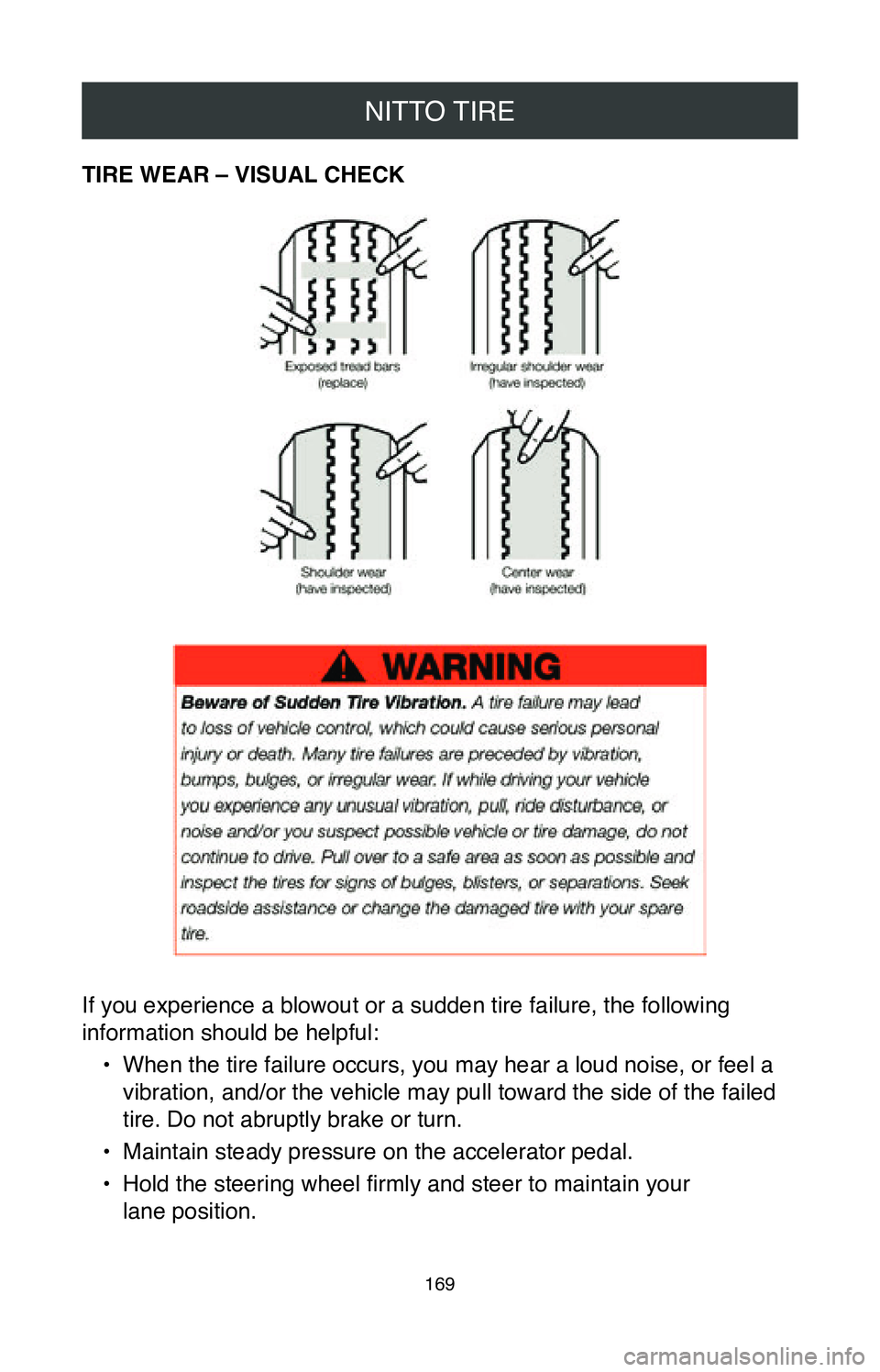
NITTO TIRE
169
TIRE WEAR – VISUAL CHECK
If you experience a blowout or a sudden tire failure, the following
information should be helpful:•
When the tire failure occurs, you may hear a loud noise, or feel a
vibration, and/or the vehicle may pull toward the side of the failed
tire. Do not abruptly brake or turn.
•
Maintain steady pressure on the accelerator pedal.
•
Hold the steering wheel firmly and steer to maintain your
lane position.
Page 172 of 260
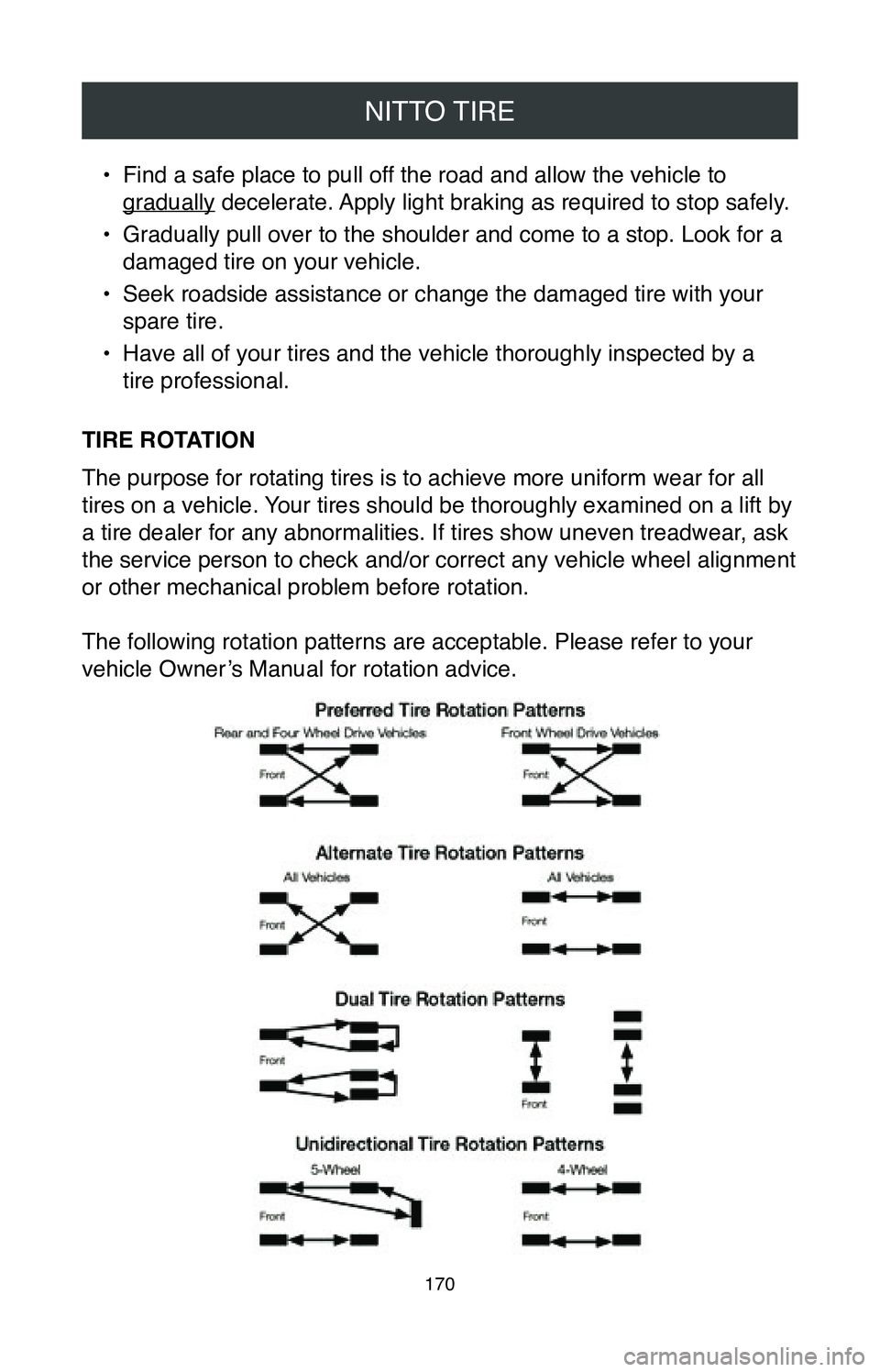
NITTO TIRE
170
• Find a safe place to pull off the road and allow the vehicle to
gradually decelerate. Apply light braking as required to stop safely.
•
Gradually pull over to the shoulder and come to a stop. Look for a
damaged tire on your vehicle.
•
Seek roadside assistance or change the damaged tire with your
spare tire.
•
Have all of your tires and the vehicle thoroughly inspected by a
tire professional.
TIRE ROTATION
The purpose for rotating tires is to achieve more uniform wear for all
tires on a vehicle. Your tires should be thoroughly examined on a lift by
a tire dealer for any abnormalities. If tires show uneven treadwear, ask
the service person to check and/or correct any vehicle wheel alignment
or other mechanical problem before rotation.
The following rotation patterns are acceptable. Please refer to your
vehicle Owner’s Manual for rotation advice.
Page 173 of 260

NITTO TIRE
171
Full-size spare tires (not temporary spares) of the same size,
construction, and speed rating may be used in a five-tire
rotation pattern.
After rotation, check the inflation pressure of all the tires. The front
and rear tire pressures may vary according to the vehicle
manufacturer’s specifications.
Remember to follow your vehicle Owner’s Manual for tire rotation
intervals. Your Limited Warranty recommends Nitto brand tires to be
rotated as follows:
•
Every 3,500 miles or less for high performance (low profile) tires.
•
Every 7,500 miles or less for standard passenger and light
truck tires.
More frequent rotation or a thorough vehicle inspection may be
necessary if, upon inspection, irregular or erratic treadwear is
beginning to appear.
It is important to remember the following: •
These tire rotation recommendations do not take into account
different tire and construction types mixed on the vehicle.
•
Some tires cannot be rotated in the manner described. Such tires
include unidirectional tires. Unidirectional tread patterns must be
rotated front-to-rear only so that the direction of revolution does
not change.
•
Some vehicles are designed with different tire sizes on the front
and rear axles. Normally, such combinations will not allow rotation.
Prior to rotating, consult the vehicle Owner’s Manual.
•
For vehicles with dual rear wheels, see the vehicle Owner’s
Manual for the vehicle manufacturer’s procedures. If your vehicle
Owner’s Manual is not available, please contact the vehicle
manufacturer.
•
Some vehicles are equipped with wheels that limit the choice of
rotation pattern. Consult the vehicle Owner’s Manual.
•
Do not include temporary spare tires in the rotation pattern.
However, if your spare tire is the same size and type as a road tire
(for LT tires of the same size, type, and load rating), it should be
Page 174 of 260

NITTO TIRE
172
included in the tire rotation process. The proper procedure is to use
the vehicle manufacturer’s recommended tire rotation procedures,
or if not available, to use the appropriate rotation pattern shown,
inserting the spare in the right rear position. Place the tire that
would have gone to the right rear in the spare tire storage position
as the new spare.
•
Important! After rotation, adjust the pressure of the individual tires
to the vehicle manufacturer’s recommendation or the inflation
pressure recommended by Nitto for an optional fitment according
to the tire’s new location on the vehicle.
•
Do not mix speed-rated tires on the same axle. Higher speed-
rated tires must remain on the rear axle. Consult your authorized
Nitto dealer.
TIRE SPEED RATING
All Nitto passenger and light truck tires have a maximum speed rating
based on size and type. Tires must never be operated in excess
of their rated speed limit! Consult your tire dealer or contact Nitto
Technical Services at (888) 529-8200 Pacific Time if you are not sure
about the maximum speed rating of your tires.
Nitto does not endorse the operation of any vehicle in an unsafe or
unlawful manner. Obey all local speed limits.
Tire speed ratings do not imply that a vehicle can be safely driven
at the speed for which the tire is rated. Speed ratings are based on
laboratory tests and relate to performance on the road, but are not
applicable if tires are underinflated, overloaded, worn out, damaged,
or altered.
Page 175 of 260

NITTO TIRE
173
EXPLANATION OF TIRE SPEED SYMBOLS
A speed rating is designated by a letter that indicates the maximum
speed capability of a tire. The speed rating of a tire is based on
standards for reaching and sustaining a specified speed, and is
determined via laboratory tests that simulate road performance at
various speeds.
Tires may be marked with one of these speed symbols: M, N, P, Q, R,
S, T, U, H, V, W, Y, or (Y) to identify the particular tire’s speed rating.
Additionally, the letter Z may appear in the size designation.
When purchasing or replacing speed-rated tires, make sure to:•
Use the ranking in the following chart to compare the speed
symbols of all the tires.
•
Follow the vehicle manufacturer’s recommendations, if any,
concerning the use of speed-rated tires.
To avoid reducing the speed capability of the vehicle, replace a speed-
rated tire only with another tire having at least the same or higher
speed rating. Remember, the “top speed” of the “lowest rated” tire on
the car cannot be exceeded without risk of tire failure.
Page 176 of 260
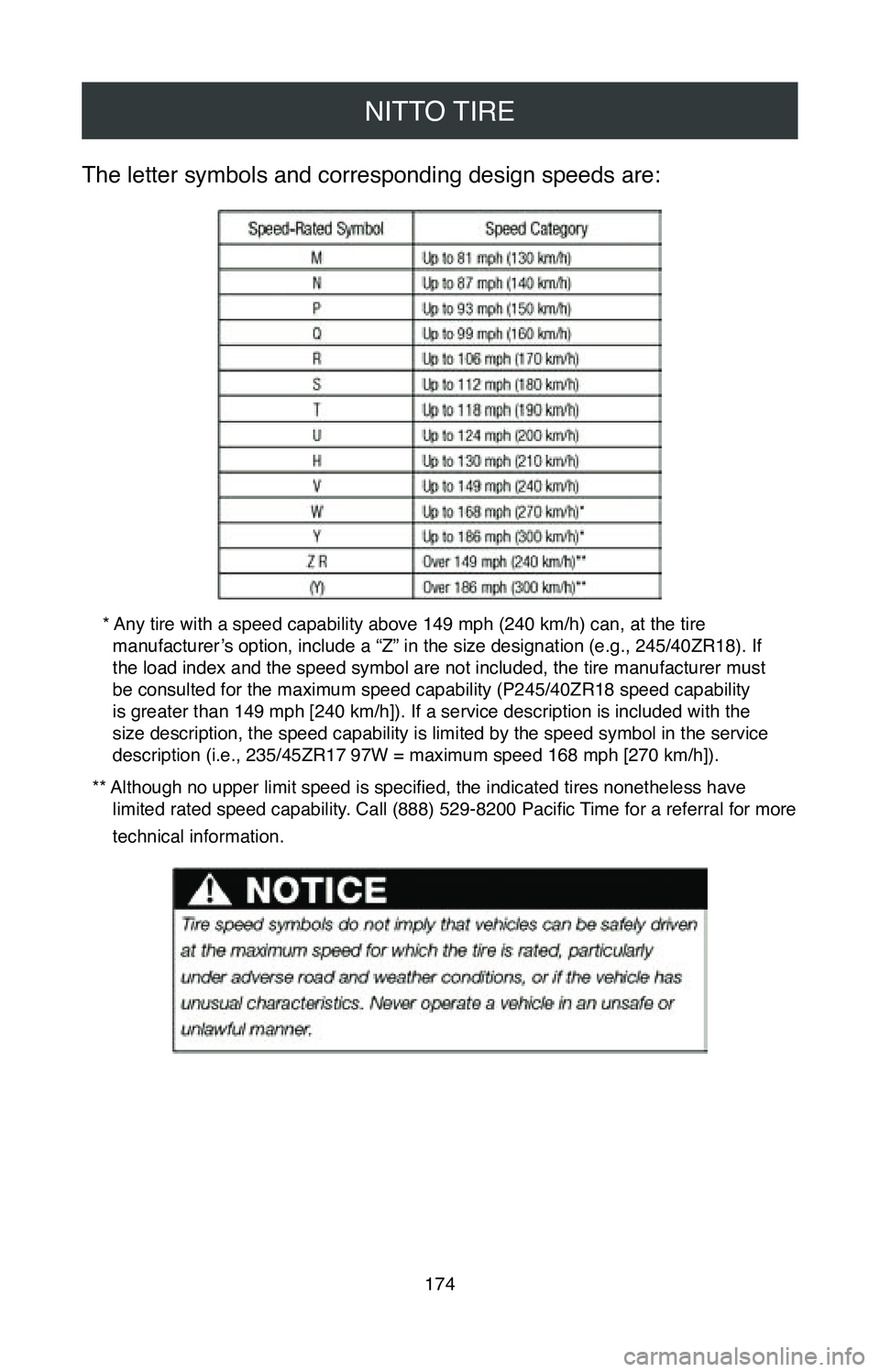
NITTO TIRE
174
The letter symbols and corresponding design speeds are:
* Any tire with a speed capability above 149 mph (240 km/h) can, at the tire manufacturer’s option, include a “Z” in the size designation (e.g., 245/40ZR18). If
the load index and the speed symbol are not included, the tire manufactu\
rer must
be consulted for the maximum speed capability (P245/40ZR18 speed capability
is greater than 149 mph [240 km/h]). If a service description is included with the
size description, the speed capability is limited by the speed symbol in\
the service
description (i.e., 235/45ZR17 97W = maximum speed 168 mph [270 km/h]).
** Although no upper limit speed is specified, the indicated tires nonetheless have limited rated speed capability. Call (888) 529-8200 Pacific Time for a referral for more
technical information.
Page 177 of 260
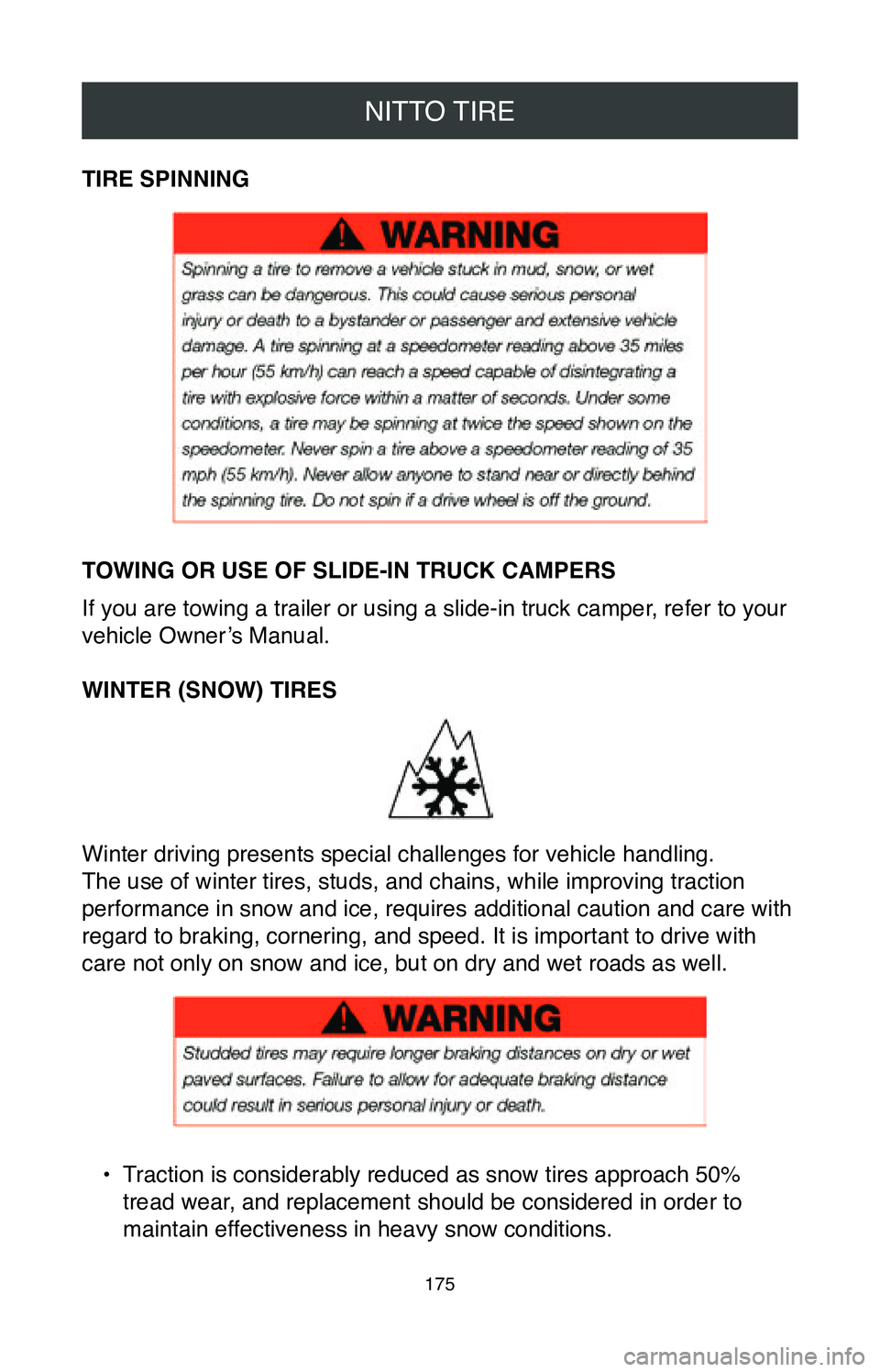
NITTO TIRE
175
TIRE SPINNING
TOWING OR USE OF SLIDE-IN TRUCK CAMPERS
If you are towing a trailer or using a slide-in truck camper, refer to your
vehicle Owner’s Manual.
WINTER (SNOW) TIRES
Winter driving presents special challenges for vehicle handling.
The use of winter tires, studs, and chains, while improving traction
performance in snow and ice, requires additional caution and care with
regard to braking, cornering, and speed. It is important to drive with
care not only on snow and ice, but on dry and wet roads as well.
• Traction is considerably reduced as snow tires approach 50%
tread wear, and replacement should be considered in order to
maintain effectiveness in heavy snow conditions.
Page 178 of 260
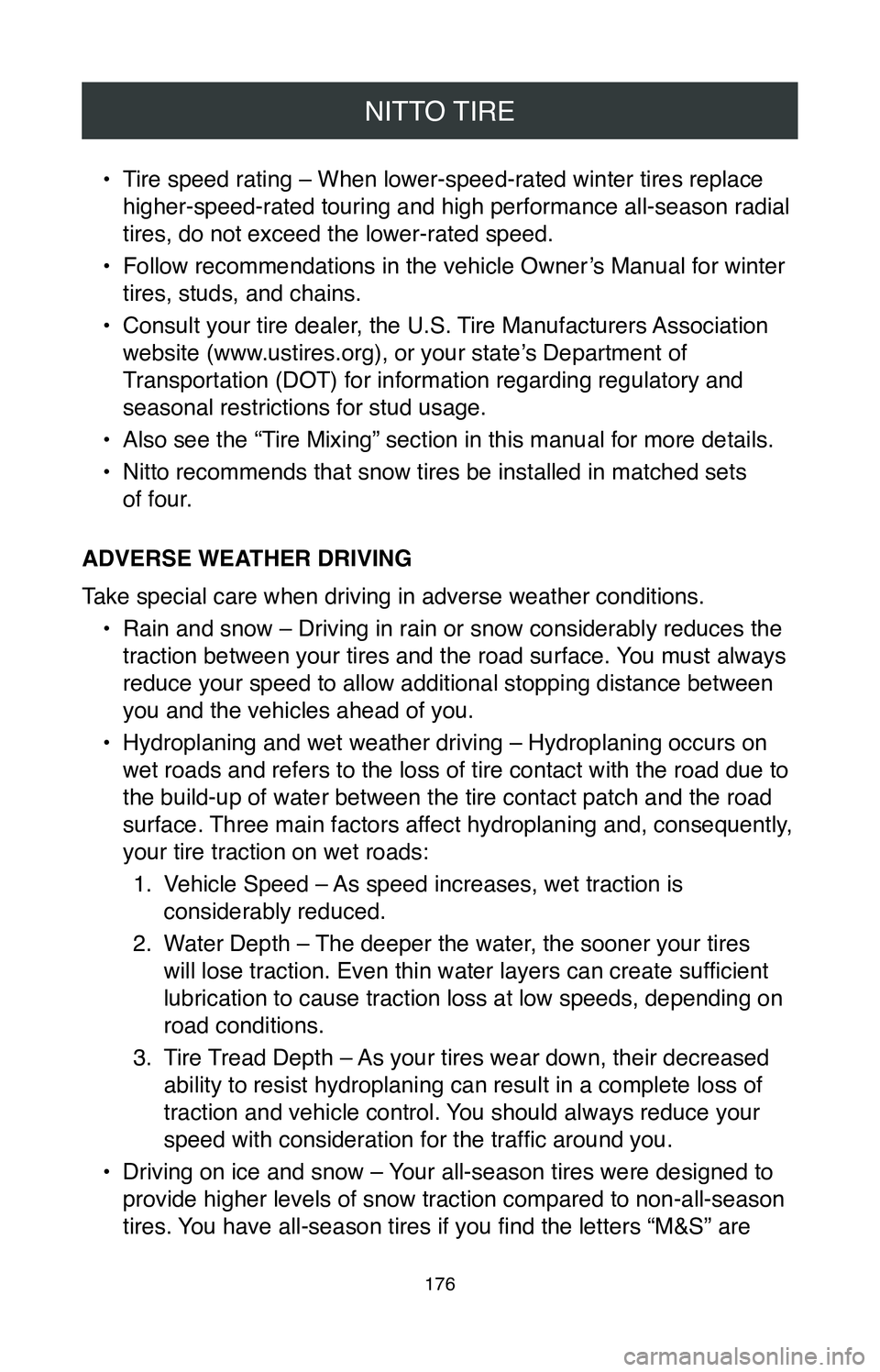
NITTO TIRE
176
• Tire speed rating – When lower-speed-rated winter tires replace
higher-speed-rated touring and high performance all-season radial
tires, do not exceed the lower-rated speed.
•
Follow recommendations in the vehicle Owner’s Manual for winter
tires, studs, and chains.
•
Consult your tire dealer, the U.S. Tire Manufacturers Association
website (www.ustires.org), or your state’s Department of
Transportation (DOT) for information regarding regulatory and
seasonal restrictions for stud usage.
•
Also see the “Tire Mixing” section in this manual for more details.
•
Nitto recommends that snow tires be installed in matched sets
of four.
ADVERSE WEATHER DRIVING
Take special care when driving in adverse weather conditions. •
Rain and snow – Driving in rain or snow considerably reduces the
traction between your tires and the road surface. You must always
reduce your speed to allow additional stopping distance between
you and the vehicles ahead of you.
•
Hydroplaning and wet weather driving – Hydroplaning occurs on
wet roads and refers to the loss of tire contact with the road due to
the build-up of water between the tire contact patch and the road
surface. Three main factors affect hydroplaning and, consequently,
your tire traction on wet roads: 1.
Vehicle Speed – As speed increases, wet traction is
considerably reduced.
2.
Water Depth – The deeper the water, the sooner your tires
will lose traction. Even thin water layers can create sufficient
lubrication to cause traction loss at low speeds, depending on
road conditions.
3.
Tire Tread Depth – As your tires wear down, their decreased
ability to resist hydroplaning can result in a complete loss of
traction and vehicle control. You should always reduce your
speed with consideration for the traffic around you.
•
Driving on ice and snow – Your all-season tires were designed to
provide higher levels of snow traction compared to non-all-season
tires. You have all-season tires if you find the letters “M&S” are
Page 179 of 260
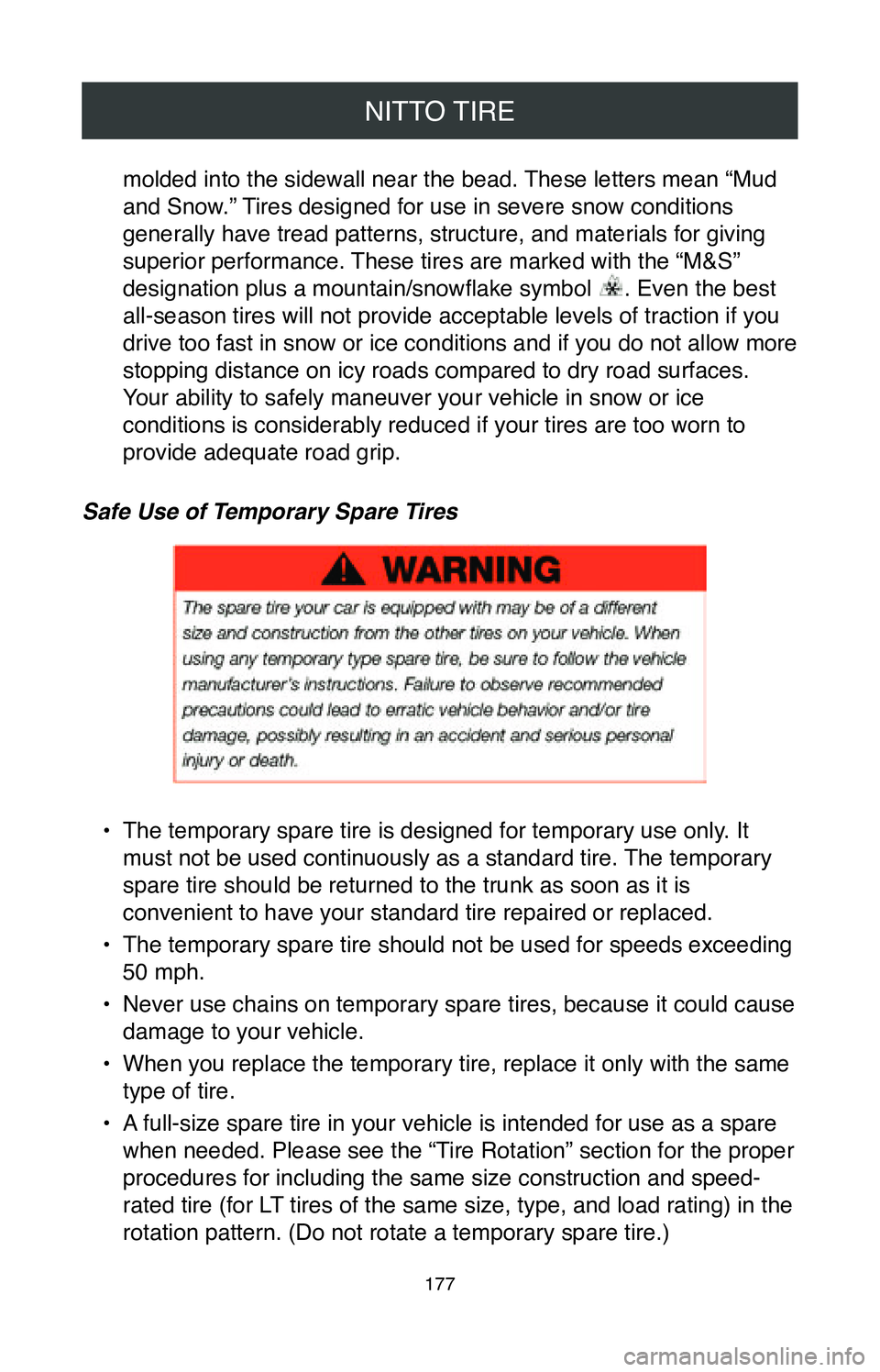
NITTO TIRE
177
molded into the sidewall near the bead. These letters mean “Mud
and Snow.” Tires designed for use in severe snow conditions
generally have tread patterns, structure, and materials for giving
superior performance. These tires are marked with the “M&S”
designation plus a mountain/snowflake symbol
. Even the best
all-season tires will not provide acceptable levels of traction if you
drive too fast in snow or ice conditions and if you do not allow more
stopping distance on icy roads compared to dry road surfaces.
Your ability to safely maneuver your vehicle in snow or ice
conditions is considerably reduced if your tires are too worn to
provide adequate road grip.
Safe Use of Temporary Spare Tires
• The temporary spare tire is designed for temporary use only. It
must not be used continuously as a standard tire. The temporary
spare tire should be returned to the trunk as soon as it is
convenient to have your standard tire repaired or replaced.
•
The temporary spare tire should not be used for speeds exceeding
50 mph.
•
Never use chains on temporary spare tires, because it could cause
damage to your vehicle.
•
When you replace the temporary tire, replace it only with the same
type of tire.
•
A full-size spare tire in your vehicle is intended for use as a spare
when needed. Please see the “Tire Rotation” section for the proper
procedures for including the same size construction and speed-
rated tire (for LT tires of the same size, type, and load rating) in the
rotation pattern. (Do not rotate a temporary spare tire.)
Page 180 of 260
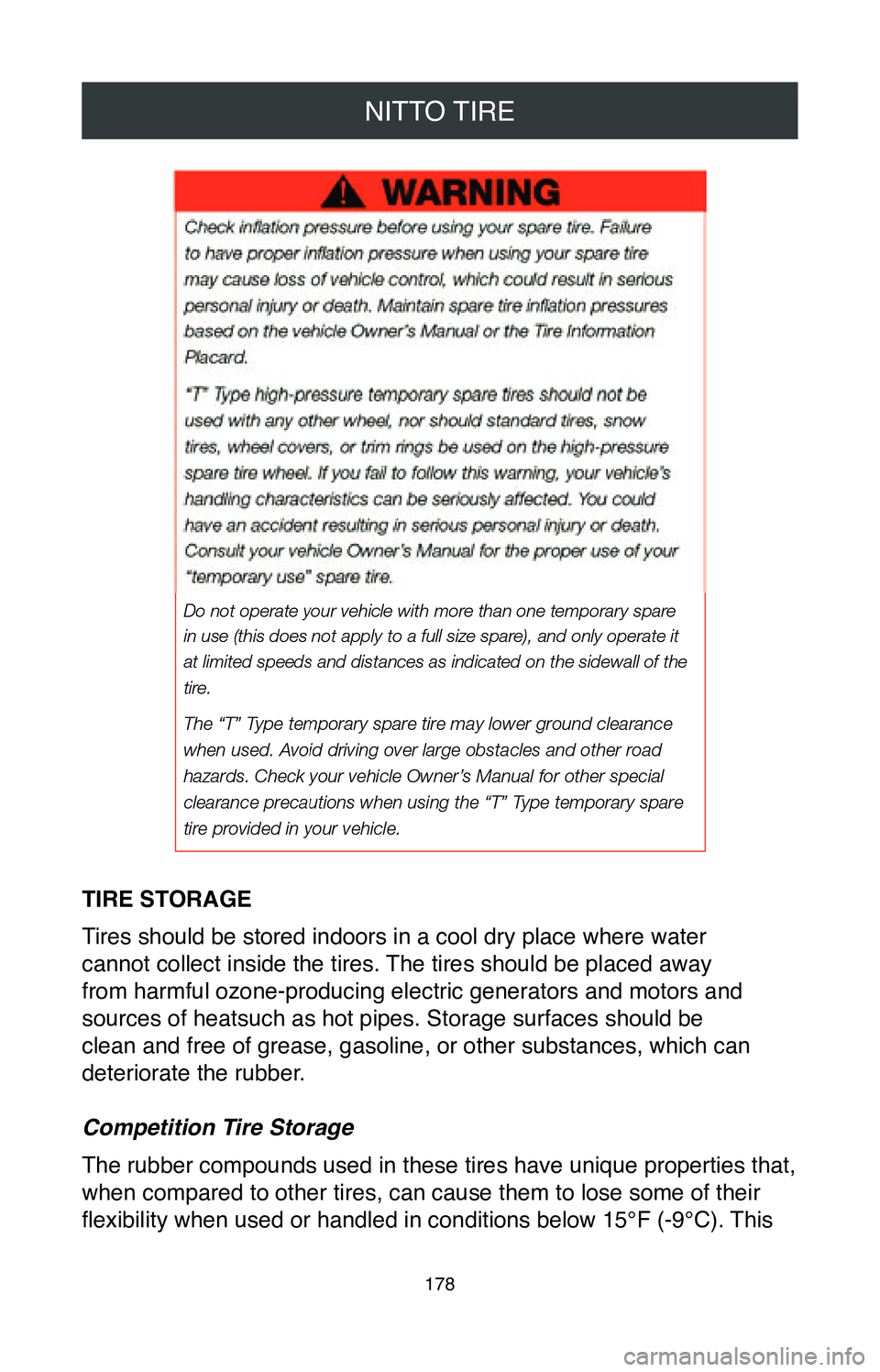
NITTO TIRE
178
TIRE STORAGE
Tires should be stored indoors in a cool dry place where water
cannot collect inside the tires. The tires should be placed away
from harmful ozone-producing electric generators and motors and
sources of heatsuch as hot pipes. Storage surfaces should be
clean and free of grease, gasoline, or other substances, which can
deteriorate the rubber.
Competition Tire Storage
The rubber compounds used in these tires have unique properties that,
when compared to other tires, can cause them to lose some of their
flexibility when used or handled in conditions below 15°F (-9°C). This